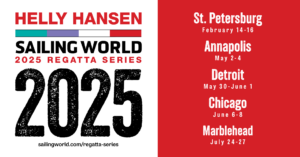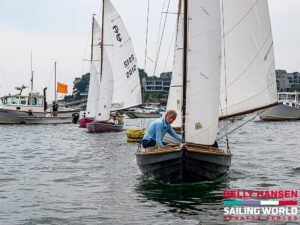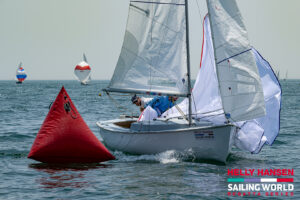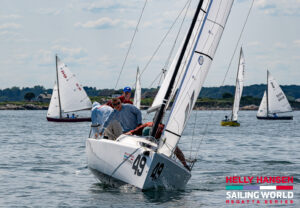It only takes a pause before Rod Jabin pulls a favorite memory from more than a decade of racing Farr 30s: It’s the 2015 Farr 30 World Championship in Seattle, far from his hometown of Annapolis, Maryland, when a big weather front sweeps across the racecourse just as Jabin’s Ramrod is rounding the weather mark.
“We’d just set the kite when a 28-knot front came through and we were blasting along at 18 knots in the old girl. It was full planing, hanging on, and everyone else is wiping out around us. We were able to stay on our feet all the way down to the bottom mark where I turned around and saw that everyone else was gone. It’s fun when it gets really fast and you’re able to not wipe out. That got the heart rate going for sure.”
Before getting into the Farr 30 class, Jabin, who owns Annapolis’ premier marina, campaigned a Farr 40. And, like other Farr 40 owners at the time, the little sister from the local design office made for an excellent training platform. The switch to a smaller boat was natural transition for Jabin. “It’s similar to the Farr 40 in that it’s a fun boat that feels like a big-keel spade-rudder boat, versus a higher aspect rudder, thinner keel boat like the Melges 32.”
Every once in a while, “the magic happens” with raceboat design, says Jabin, and the Farr 30 is one example, a boat that has stood the test of time and remains one of the best one-designs of all time. The combination of sail area, beam, draft, and displacement make it a fun and challenging boat to sail upwind and downwind. It demands perfect crew work and meticulous preparation. “With the help of professionals like Chris Larson and Darren Jones we’ve worked hard to get the last little bit out of this thing.”
Farr 30s around the world have been turbo-charged and refined to the nth degree by professional teams, but the final percentage in boatspeed available to teams today, says Jabin, is found in technique, rig tune, and sails. “We’re continually looking at sail designs and improving those,” he says. “Where do we go from here? I don’t know.”
With the Farr 30 class having recently lost its international status, says Jabin, the class is struggling to reimagine itself, but he’s moving forward with a solution to put new life in the old girl, speeding her up with an asymmetric spinnaker quiver for local handicap racing.
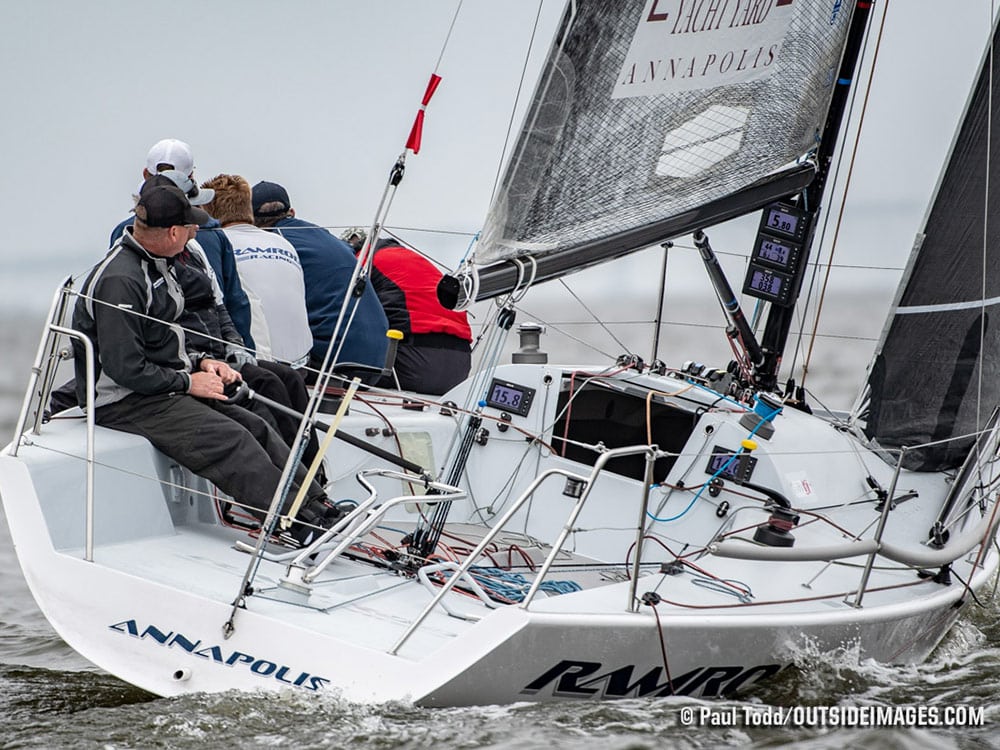
“I’ve ordered a prod and some asymmetric sails, which takes it away from its one-design configuration,” he says, “but we think it will introduce a whole level of excitement to the boat and the class. Hopefully, the other guys will follow me. We’re excited about something new and fresh for us. I think it will definitely be faster, and whether it works out rating-wise, I’m not sure.”
The six-foot prod will be bolted to the bow, and as a result, will dramatically change how they sail the boat downwind. “We’ll add a bunch of turning blocks and ropes and try to figure out how to sheet things,” says Jabin. “A fractional code zero will be unbelievable.”
“The boat was not initially built to support a masthead code zero or asymmetric sails. These [new] sails are probably 100 square meters larger, so the first thing we did was go to Southern [Spars] and ask how much the rigs could take. Working with them, we’re making sure the sails are flat enough that we get forward speed instead of rolling the boat on its side.”
It’ll be a dramatic change to Ramrod, which Jabin bought in 2010, but it’s a due improvement that could entice new teams to Farr 30 racing. There are plenty of used boats available, many in excellent racing condition already. “I don’t know how many were built—just a lot—and there are a lot around the world and all over the place,” he says, pointing out the blue-decked boat in the adjacent slip. “Kevin McNeill’s boat is a museum quality Farr 30, right there. You can continue to work and improve them.”
Jabin’s recommendation for curious about used Farr 30s is to make sure the deck is sound and dry. “They used balsa core so some high-load areas can be soft,” he says. “Just make sure the keel-to-hull joint is good. It’s best if the boat’s been drysailed. I can take any Farr 30 and turn it into one of the best Farr 30s in the world without a whole lot of work. It’s old school technology.”
Ramrod, understandably, is in prime condition, and Jabin says the major projects of late have been to replace the rudder bearings and tube to make his helm “silky smooth.” They repainted deck with in-laid trim marks and re-cored areas around winches. “The biggest thing really has been the sail inventory,” he says. “Continuing to work with the guys at North to make sure we have the latest design and be as fast as we can be. To get it to fit the rig and the mast bend characteristics is key.”
The Farr 30 demands fluid crew mechanics, and there are key positions on every boat, says Jabin, who sails with seven crew. The crucial parts, he says, are certainly the bowman and the trimmers. “Because this boat is so physical when it gets windy and we don’t dip-pole jibe, it’s end-to-end, so it’s a big job to slam the pole up there. Trimmers are crucial because they can make or break you. This boat reacts to the load on the mainsheet, which is absolutely the throttle. The trimmers have to be on their game.”

